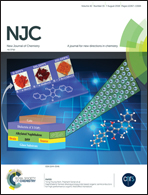Role of a 2,3-bis(pyridyl)pyrazinyl chelate bridging ligand in the reactivity of Ru(ii)–Pt(ii) dinuclear complexes on the substitution of chlorides by thiourea nucleophiles – a kinetic study†
Abstract
Chloride substitution from [(1,10-phenanthroline)2Ru(II)(μ-2,3-bis(2-pyridyl)pyrazine)Pt(II)dichloride]2+ (RuPt1), [(1,10-phenanthroline)2Ru(II)(μ-2,3-bis(2-pyridyl)quinoxaline)Pt(II)dichloride]2+ (RuPt2) and [(1,10-phenanthroline)2Ru(II)(μ-2,3-bis(2-pyridyl)benzo[g]quinoxaline)Pt(II)dichloride]2+ (RuPt3) by thiourea (TU), 1,3-dimethyl-2-thioura (DMTU) and 1,1,3,3-tetra methyl-2-thiourea (TMTU) was studied in a methanol medium (I = 0.10 M) under pseudo-first-order conditions. The rate of substitution was investigated as a function of concentration of nucleophile and temperature using the stopped-flow technique. Two consecutive substitution steps were observed. The first and fastest step was ascribed to the simultaneous substitution of the two chloride co-ligands by incoming nucleophiles according to the rate law: k1stobs = k1st2[Nu]. The subsequent step was assigned to the dechelation of the rigid 2,3-bis(pyridyl)pyrazinyl bridging ligand from the Pt(II) centres of the substituted intermediates to give Pt(Nu)42+ and (phen)2Ru(II)(2,3-bis(pyridyl)pyrazinyl) groups as products. The rate law for this step is k2ndobs = k2nd2[Nu] + k2nd−2. The second-order kinetics and large negative entropies for both steps support an associative mechanism of substitution. The rate of chloride substitution was RuPt1 ≪ RuPt2 < RuPt3. This is also the order of increase in the π-surface of the bridging ligand and an indication that π-back donation of electron density from the Pt-5dπ orbitals into the π*-acceptor bridging ligand is the dominant factor controlling the substitution of the chloride from the complexes. The nucleophiles’ order of reactivity was TU > DMTU > TMTU, in accordance with their steric bulk.



 Please wait while we load your content...
Please wait while we load your content...